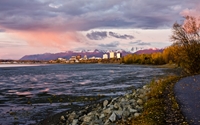Though weather changes on a regular basis, a change of high and low pressure systems can greatly impact the direction of a storm. At times, residents will barely miss a strong storm because of these shifts, while others are anticipating its mercy.
Alaska may be the United States' largest territory, but in some ways, news from the area is less likely to gain public attention. Cities and towns are scattered many miles away from one another, which means assistance after a storm may take longer to arrive than in other states where towns are more condensed. Such a situation has been a concern for two villages near the Bering Sea and Yukon River Delta, the Anchorage Daily News reported.
Since last weekend, Stebbins and Kotlik have been suffering from a string of winter storms that have destroyed local freshwater sources and electricity. Unforunately, these communities are still waiting to receive aid from the state or neighboring towns.
When it is hard to reach specific areas, these villages could benefit from a continuity of operations plan. This way, residents will be more prepared to wait for public assistance when travel is limited. With a combined 1,156 population, residents are feeling outside of the public eye because of the Haiyan typhoon that attacked the central Philippinies around the same time, the Alaska Dispatch explained.
"It feels like we are being ignored, like we are not important," resident Rita Asgeirsson wrote on Governor Sean Parnell's Facebook page. "It feels like we don't matter because we are not thousands of people and we aren't in an urban area."
When saltwater is surrounding exposed pipes and homes, damage is likely to become much worse. Donna Erickson of Unalakleet told the News that a large share of their power tools and camping equipment may not be salvagable. Most residents decided to seek refuge in Kotlik's school before another winter storm attacked the community again on Wednesday.
Natural disasters can happen in any part of the U.S., which is why it is so important to be prepared for the worst case scenario. If a region is known for speciifc events, developing a plan for them is essential. Business continuity consultants can instill such confidence in communities.

